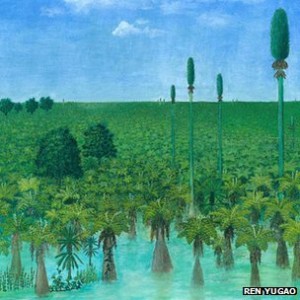The researchers were able to “reconstruct” nearly 1,000 sq m of the forest’s trees and plant distributions.
This rare insight into how the region once looked is described in Proceedings of the National Academy of Sciences.
The excavations sampled three sites across a large expanse that was covered with about a metre of ash.
Due to the pristine preservation of some of the plants, the team estimate the ash fell over the course of just a few days, felling and damaging some of the trees and plants under its weight but otherwise keeping them intact.
“It’s marvelously preserved,” said study co-author Hermann Pfefferkorn of the University of Pennsylvania in the US.
“We can stand there and find a branch with the leaves attached, and then we find the next branch and the next branch and the next branch. And then we find the stump from the same tree. That’s really exciting.”
The team identified six groups of trees, ranging from low-lying tree ferns to now-extinct 25m trees Sigillaria and Cordaites, as well well-preserved specimens of another extinct group called Noeggerathiales.
Based on the findings, the team worked with a painter to depict what the forest would have looked like before the ash cloud descended.
Prof Pfefferkorn said that, as a particularly complete and well-caught moment in time, the forest would serve as a “baseline” for assessing future finds.
“It’s like Pompeii,” he said. “Pompeii gives us deep insight into Roman culture, but it doesn’t say anything about Roman history in and of itself.
“But on the other hand, it elucidates the time before and the time after. This finding is similar. It’s a time capsule and therefore it allows us now to interpret what happened before or after much better.”



 August 19th, 2012
August 19th, 2012  riffin
riffin 
 Posted in
Posted in  Tags:
Tags: 